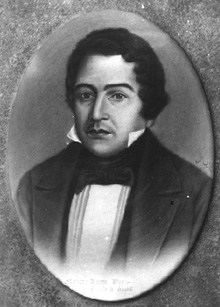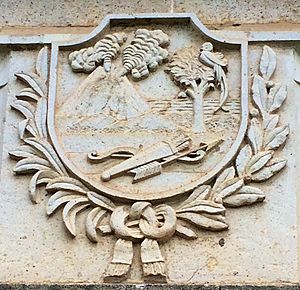Mariano Rivera Paz facts for kids
Quick facts for kids
Mariano Rivera Paz
|
|
|---|---|
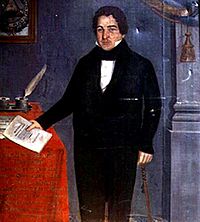
Portrait of Rivera Paz at the National History Museum of Guatemala
|
|
| Head of State of Guatemala | |
| In office 14 May 1842 – 11 December 1844 |
|
| Preceded by | José Venancio López |
| Succeeded by | Rafael Carrera (as President) |
| In office 3 December 1839 – 25 February 1842 |
|
| Preceded by | himself as Chief of State |
| Succeeded by | José Venancio López |
| Chief of State of Guatemala | |
| In office 13 April 1839 – 3 December 1839 |
|
| Preceded by | Carlos Salazar Castro |
| Succeeded by | Himself as Head of State |
| In office 29 July 1838 – 30 January 1839 |
|
| Preceded by | Pedro José Valenzuela y Jauregui |
| Succeeded by | Carlos Salazar Castro |
| Personal details | |
| Born | 24 December 1804 Guatemala City |
| Died | 26 February 1849 (aged 44) Jalapa, Guatemala |
| Political party | Liberal |
| Residence | Guatemala City |
| Alma mater | Real y Pontificia Universidad de San Carlos Borromeo |
| Profession | Lawyer, politician |
Mariano Rivera Paz (born December 24, 1804 – died February 26, 1849) was an important political leader in Guatemala. He served as the Head of State of Guatemala multiple times and later became its first president.
Contents
Biography
Mariano Rivera Paz was born in Guatemala City. He studied law at the Royal and Pontifical University of San Carlos Borromeo. His education prepared him for a career in politics.
Political Conflicts in Guatemala
In the 1830s and 1840s, Guatemala faced many political problems. There was a big fight between two main groups: the Liberals and the Conservatives.
- The Liberals wanted a government with more freedom and less power for the church. Their main leader was Francisco Morazán.
- The Conservatives wanted a stronger government and more traditional ways, often supported by the church. Their main leader was Rafael Carrera.
In 1838, Morazán's Liberal forces entered Guatemala. This led to a major conflict with Rafael Carrera, a strong leader who had the support of many farmers and local people. Carrera felt personally wronged by Morazán's actions.
Morazán's army marched into Guatemala City. They were welcomed by some leaders, including Pedro Valenzuela. Morazán then replaced Valenzuela with Mariano Rivera Paz. Rivera Paz was a Conservative, but Morazán hoped this would help calm things down.
However, the fighting continued. Carrera, despite being outnumbered, used clever tactics. He often surprised Morazán's troops. In April 1839, Carrera managed to take over Guatemala City. After this, he put Rivera Paz back in charge as the Head of State.
The State of Los Altos
In 1838, a group in the city of Quetzaltenango decided to form their own independent state called Los Altos. This region was very important for Guatemala's economy. Many Liberals who were against the Conservative government moved to Los Altos.
The government of Guatemala, led by Rivera Paz, tried to find a peaceful solution. But the leaders of Los Altos did not agree. So, the Guatemalan government sent Rafael Carrera and his army to bring Los Altos back under control.
Carrera defeated the Los Altos forces. He warned the leaders there that he would not be merciful if they tried to break away again. The leaders of Los Altos were sent to Guatemala City. After this, Los Altos was officially made part of Guatemala again.
Morazán's Final Defeat
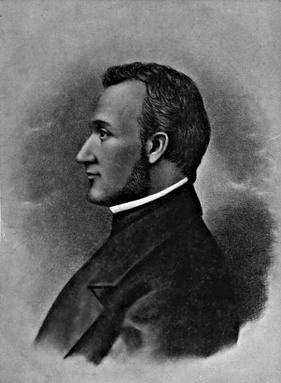
In March 1840, Francisco Morazán invaded Guatemala again with a large army. He wanted to get revenge for what happened in Los Altos and keep the Central American Federation together.
Carrera prepared his defense. He tricked Morazán into thinking his army was weak. Morazán easily took Guatemala City. But Carrera then launched a surprise attack. His soldiers knew the city streets well. Morazán's troops, tired from their long march, were caught off guard.
Carrera's strategy worked perfectly. He defeated Morazán's army completely. Morazán had to escape to save his life. This major defeat ended Morazán's political career in Central America. It also made Rafael Carrera a very powerful figure in Guatemala.
After this victory, Carrera went back to Quetzaltenango. He made sure Los Altos would not try to become independent again. He took strong actions against the Liberal leaders there. This event further strengthened Carrera's power and his alliance with the local people.
Presidency
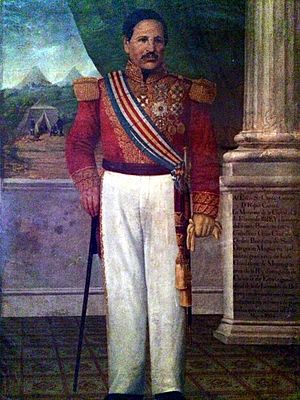
Mariano Rivera Paz served as Head of State and later as the first President of Guatemala. His time in office was very challenging because of all the political unrest. However, he had the strong support of Rafael Carrera, who was a key military leader.
In December 1844, Rivera Paz decided to resign from his position. This was partly due to the strong influence and demands from Rafael Carrera.
Belgium's Attempt to Colonize
In 1840, the country of Belgium tried to gain influence in Central America. A Belgian company, supported by King Leopold I, took control of Santo Tomas de Castilla for a short time. They hoped to establish a colony there.
Death
The eastern part of Guatemala, especially the Jalapa region, remained dangerous due to ongoing conflicts. On February 26, 1849, Mariano Rivera Paz went to Jalapa to take on a new government role. Sadly, he was killed there by two men named Roberto Reyes and Agustín Pérez.
See also
 In Spanish: Mariano Rivera Paz para niños
In Spanish: Mariano Rivera Paz para niños
- Francisco Morazán
- Los Altos, Central America
- Presidents of Guatemala
- Rafael Carrera


